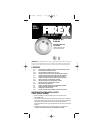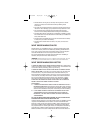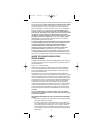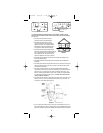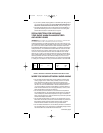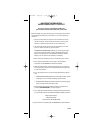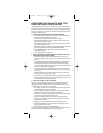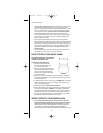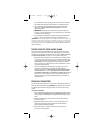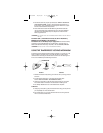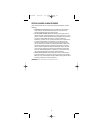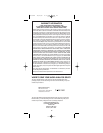
• If you have a peaked, sloped, gabled or cathedral-style ceiling, mount
your smoke alarm 4 to 36 inches (3 feet) MEASURED HORIZONTALLY
FROM THE HIGHEST POINT ON THE CEILING, as shown in Figure 4.
• Do install smoke alarms in both rooms (areas) that are divided by a
partial wall extending 8 or more inches down from the ceiling. See
smoke alarms located in rooms B and C in Figure 4.
SPECIAL DIRECTIONS FOR INSTALLING
YOUR SMOKE ALARM IN MANUFACTURED
AND MOBILE HOMES
!WARNING: SMOKE ALARMS MAY BE INSTALLED ON THE CEILINGS OF MANUFACTURED
AND MOBILE HOMES IF THERE IS ADEQUATE INSULATION IN THE CEILING
.
Install smoke alarms on walls only between 4 and 12 inches from the ceil-
ing. Install smoke alarms on inside walls in older homes or in homes where
you are not sure of the insulation level. In older homes (manufactured in
approximately 1976 or before) that have little or no insulation compared to
today’s standards, uninsulated metal outside walls and roofs can transfer
heat and cold from the outdoors, making the air right next to the wall or
roof hot or cold, compared to the rest of the air inside the room. These
layers of hot or cold air can prevent smoke from reaching a smoke alarm.
If your mobile home has this condition, put your smoke alarm on an inside
wall only, between 4 and 12 inches from the ceiling. If you are not sure
about the insulation in your mobile home or if you notice the outside walls
or ceiling are unusually hot or cold, put the smoke alarm on an inside wall.
WHERE YOU SHOULD NOT INSTALL SMOKE ALARMS
• Do not install a smoke alarm within close proximity of heating and
cooling supply vents or within close proximity of return or fresh air
vents. Smoke may be blown away from the smoke alarm by the
supply vents, or could be diffused or reduced by being diverted into
the return air vent. The NFPA states in Standard 72E, Section 4-4.1:
“In rooms, buildings, where forced ventilation is present, detectors
shall not be located where air from supply diffusers (“vents”) could
dilute smoke before it reaches the detector.”
• Do not install your smoke alarm in an area where the temperature
may fall below 40°F, or rise above 100°F. Smoke alarms are designed
to work safely only within these temperature ranges, and failure to
alarm, improper alarms or nuisance alarms may result from operation
outside these temperature limits.
• Do not install a smoke alarm in a damp or very humid areas such as
bathrooms with showers, where the normal humidity may rise above
93% relative humidity. Above this level, moisture may condense
inside the smoke chamber and cause wrong or false alarms.
• Do not install a smoke alarm in an area where particles of combustion
are normally present, such as kitchens or automobile garages, unless
the smoke alarm has a False Alarm Control feature.
5
FIGURE 5: EFFICIENCYAPARTMENT AND MOBILE HOME INSTALLATION
Continued on page 6
SLEEPING
AREA
KITCHEN
LIVING
AREA
BEDROOM
BATH
KITCHEN LIVING ROOM
MOBILE HOME
EFFICIENCYAPARTMENT
110-644 10/5/00 2:17 PM Page 5



